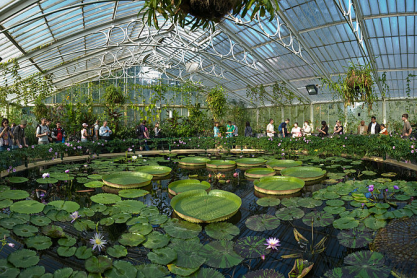The development of Kew as we know it began in the 17th century, a time when the Royals used Kew Palace as their summer residence. The mother of George III, Princess Augusta, was a keen garden enthusiast and it was her work with the 3rd Earl of Bute, an accomplished Botanist, which founded the Botanic Gardens. George III continued his mother’s work, and in 1759 William Aiton, the first gardener at Kew, was recruited from the medicinal herb Chelsea Physick Garden to manage the Physick Garden at Kew. For this reason, 1759 is considered Kew’s official birthdate.
The development of Kew involved many Royals, collectors and gifted gardeners. Among the most influential of these was Joseph Banks. A renowned explorer, Banks brought thousands of plants from around the world to Kew, establishing its status as the greatest botanical collection in the world.
In modern times, the Royal Botanic Gardens, Kew, is a non-departmental public body, sponsored by the UK Department for Environment, Food and Rural Affairs (DEFRA). It hosts an enormous scientific collection of plants and fungi, with 8.5 million items; the collections represent over 95% of known angiosperm genera, and 60% of known genera of fungi.
Kew is also a leading centre of botanical research, with scientific activities and collaborations in 110 countries across the globe. Kew has over 250 scientists, technicians and curators at the Herbarium, Jodrell Laboratory and the Wellcome Trust Millennium Building in Wakehurst. The pioneering Millennium Seed Bank aims to preserve 25% of the world’s plants by 2020, providing a crucial research resource as changing climates threaten plant species worldwide.
Our scientific vision is to document and understand global plant and fungal diversity and its uses, bringing authoritative expertise to bear on the critical challenges facing humanity today
Kew website
Kew aims to promote plant science, and the 132ha gardens at Kew are an important visitor attraction. The Gardens now host more than 50 000 plants, with the Herbarium, Princess of Wales Conservatory, Waterlily House and 18th century Pagoda just some of the many beautiful places to explore.
In 2003 Kew Gardens became a UNESCO World Heritage site, and in 2015 BBC created a documentary on the edible plants at Kew, entitled Kew on a Plate.




